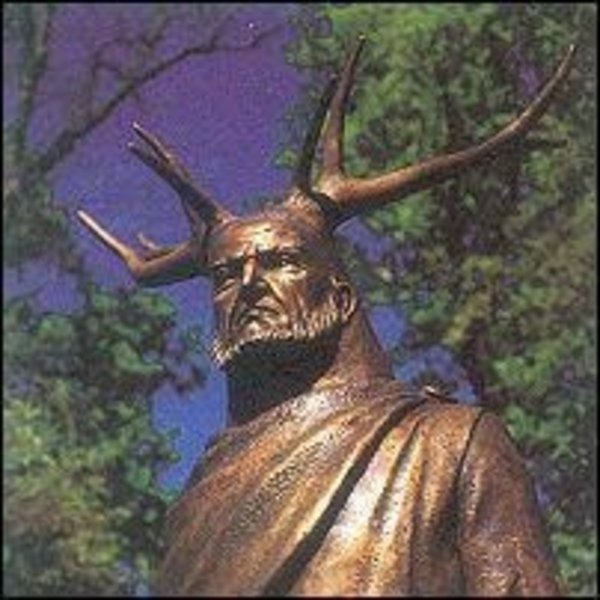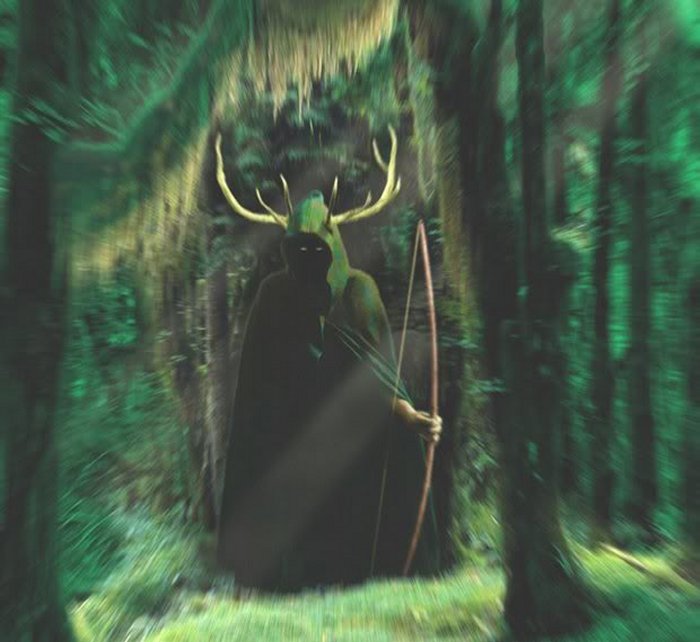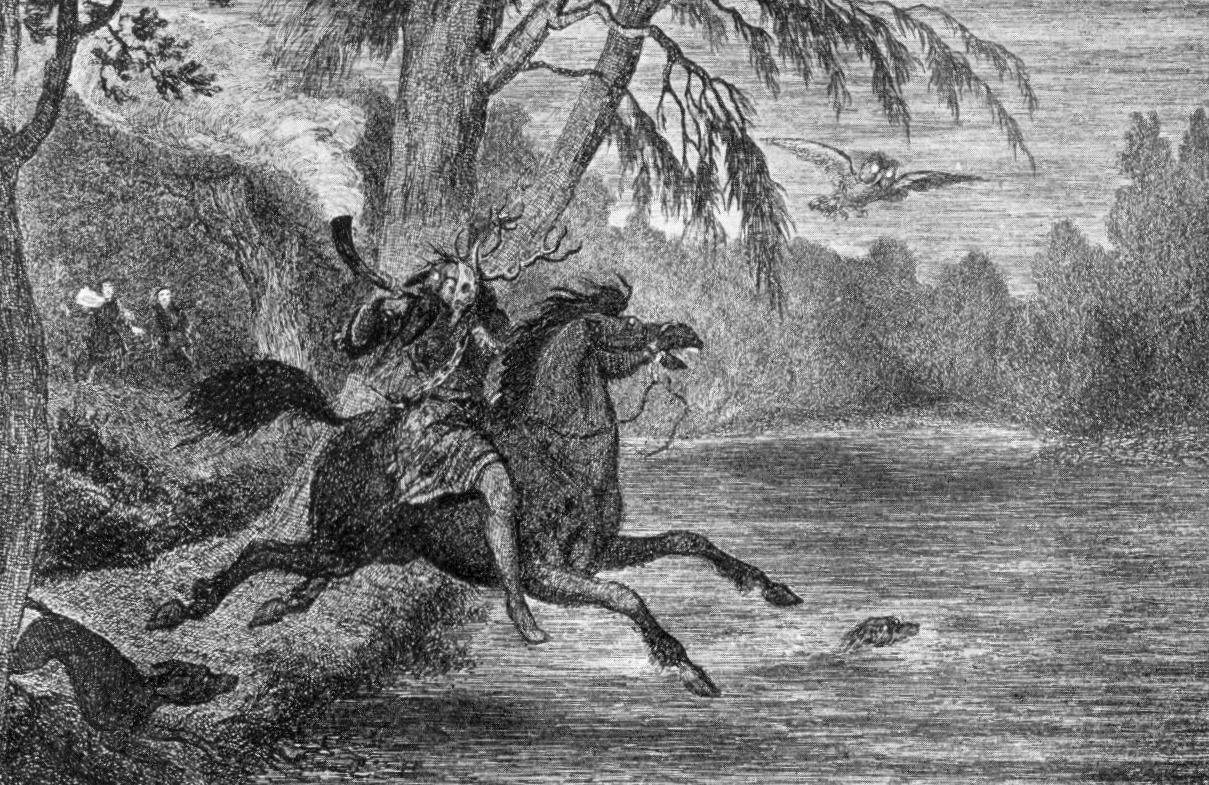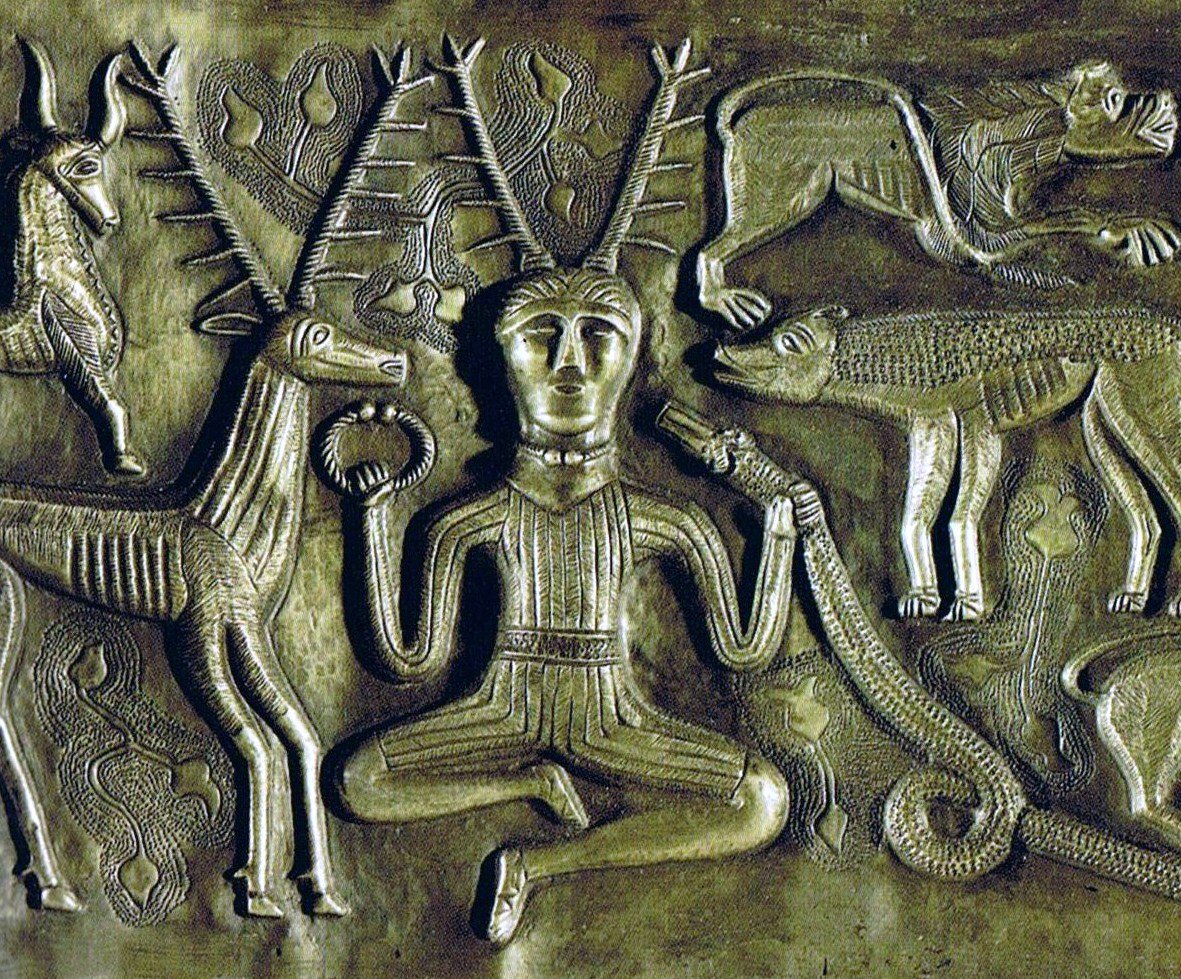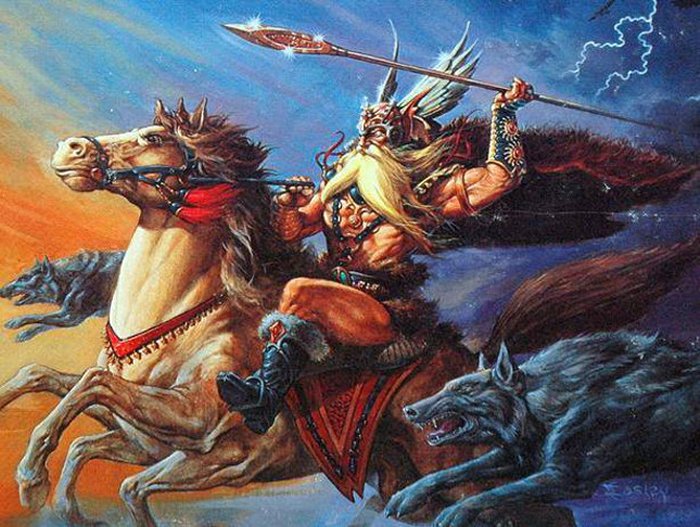Herne The Hunter – The Horned God And Lord Of The Forest In British Mythology
Ellen Lloyd - AncientPages.com - Little is known about a mysterious, mythical creature called Herne the Hunter who was said to reside in Windsor Forest and Great Park in the English county of Berkshire.
The original source for many of the tales told of Herne remains unknown. Herne the Hunter was mentioned by William Shakepeare who described him as "a spirit" and "sometime a keeper … in Windsor forest" who is seen to "walk round about an oak, with great ragged horns" at midnight during winter-time.
The Merry Wives of Windsor’ : William Shakespeare
‘There is an old tale goes, that Herne the hunter,
Sometime a keeper here in Windsor forest,
Doth all the winter time at still midnight,
Walk around about an oak, with great ragg’d horns;
And there he blasts the tree, and takes the cattle;
And makes milch-kine yield blood, and shakes a chain
In a most hideous and dreadful manner.’
The Merry Wives of Windsor : William Shakespeare
‘Why, yet there want not many, that do fear
In deep of night to walk by this Herne’s oak.’
Herne the Hunter in British Mythology
Is there a true story behind the legend of Herne the Hunter? There are several versions of an old tale revealing the faith of Herne, who was a huntsman employed by King Richard II.
Soon some men became jealous of his status and accused him of poaching on the King's land. Falsely charged with treason, Herne became an outcast among his former friends. Legend tells that in despair, he hung himself from an oak tree which later became known as Herne's Oak.
There is also another version of the story. According to which Herne was fatally wounded while saving King Richard from a charging stag. He was miraculously cured by a stranger, who tied the antlers of a dead stag to the dying man's brow. The stranger demanded in payment all Herne's skill in venery. Crazed by the loss of that skill in the craft he loved, Herne fled to the forest, and hanged himself, again from the oak tree. However, every night he rides once more leading a spectral hunt, chasing the game of Windsor Forest.
On August 31 1863 the famous Windsor Oak fell from natural causes but was soon replaced by a new young Oaktree by Queen Victoria on the same spot.
Why was Herne the Hunter called Lord of the Forest?
In the area around Berkshire, Herne is depicted wearing the antlers of a great stag. He is considered a great hunter who possessed divine skills. Herne's antlers connect him to the deer, which was given a position of great honor. Legends tell that he carried a great horn and a wooden bow, riding a mighty black horse and accompanied by a pack of baying hounds. If someone crossed his path, they were swept up in it, and often taken away, destined to ride with him for eternity.
Herne with his steed, hounds and owl, observed by the Duke of Richmond and the Earl of Surrey, in Harrison Ainsworth's Windsor Castle, illustrated by George Cruikshank, c.1843.
Encountering Herne the Hunter is a bad omen, especially to the royal family. According to local legend, Herne only appears in Windsor Forest when needed, such as in times of national crisis.
Was Herne the Hunter Cernunnos, the Celtic horned god or the Norse god Odin?
There many ancient accounts of people and gods with horns. Horns represent the primal power of nature, express the unstoppable power and the majesty and throughout human history, horns have been synonymous with this strength.
The antlered god Cernunnos, whose cult is most widely attested, is usually represented with the horns of a ram or a deer, squatting on the ground, and his posture indeed recalls that of the Buddha. with a humanoid body in Celtic myth.
See also:
Orang Bunian: Mysterious Invisible Whistle People Living In Forests In Malay Folklore
Forest In Ancient Beliefs: Powerful Realm Of Good And Evil, Ghosts, Gods And Monsters
Gilgamesh And Enkidu Undertake A Dangerous Mission To Hunt Forest Giant Humbaba
There is no one particular myth concerning him, for only his image remains. The 'cer' part of his name, relating to his antlers, means ‘horned’. He is found mainly in sculpted statues and reliefs from ancient Gaul (modern France), but the clearest image is found on the silver votive cauldron, the Gundestrup Cauldron, which is described in one of our articles.
Horned animal deities played a significant role in the early civilizations of the ancient world, where the power and mysteries of the Sumerian bull gods of Sumeria and the Egyptian ram and bull gods of were transmitted into the civilizations of the ancient world.
Cernunnos, Celtic horned god. Image credit: Wikipedia
The Windsor Forest area has a heavy Saxon influence. In the Early Middle Ages, Windsor Forest came under the control of the pagan Angles who worshiped their own pantheon of gods, including Woden, who was sometimes depicted as horned, and whose Norse equivalent Odin rode across the night sky with his own Wild Hunt and hanged himself on the world tree Yggdrasil to learn the secret of the runic alphabet. It has been suggested that the name Herne is derived from the title Herian, a title used for Woden in his role as leader of fallen warriors.
Dr. Margaret Alice Murray, (1863-1963), who was a prominent British Egyptologist and anthropologist wrote in her book God of the Witches that Herne is a manifestation of Cernunnos, the Celtic horned god. The facts that the existence of Herne the Hunter has only been claimed in Berkshire, and not in the rest of the Windsor Forest area, suggests that Herne should be considered a "localized" god and could indeed be the Berkshire interpretation of Cernunnos.
Written by: Ellen Lloyd AncientPages.com
Copyright © AncientPages.com & Ellen Lloyd All rights reserved. This material may not be published, broadcast, rewritten or redistributed in whole or part without the express written permission of AncientPages.com and Ellen Lloyd
More From Ancient Pages
-
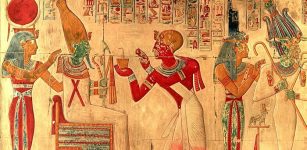 Osiris: Enigmatic And Powerful God In Ancient Egypt
Egyptian Mythology | Jun 13, 2017
Osiris: Enigmatic And Powerful God In Ancient Egypt
Egyptian Mythology | Jun 13, 2017 -
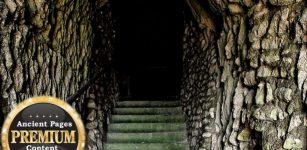 Underground Civilizations – True Rulers Of Earth – Part 1
Featured Stories | May 7, 2019
Underground Civilizations – True Rulers Of Earth – Part 1
Featured Stories | May 7, 2019 -
 Paleolithic Workshop Unearthed In The İnkaya Cave In The Turkish Western Province Of Çanakkale
Archaeology | Oct 29, 2022
Paleolithic Workshop Unearthed In The İnkaya Cave In The Turkish Western Province Of Çanakkale
Archaeology | Oct 29, 2022 -
 Unique Life-Sized Camel Carvings In Northern Arabia Are Much Older Than Previously Thought
Archaeology | Sep 15, 2021
Unique Life-Sized Camel Carvings In Northern Arabia Are Much Older Than Previously Thought
Archaeology | Sep 15, 2021 -
 Ancient Mystery Of The Menorah – Enigmatic Sacred Object With Complex History
Featured Stories | Nov 5, 2018
Ancient Mystery Of The Menorah – Enigmatic Sacred Object With Complex History
Featured Stories | Nov 5, 2018 -
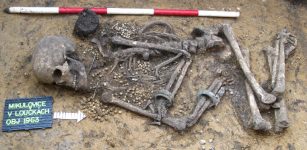 Central European Prehistory Was Highly Dynamic – New Study Shows
Archaeology | Aug 27, 2021
Central European Prehistory Was Highly Dynamic – New Study Shows
Archaeology | Aug 27, 2021 -
 Shennong – Chinese ‘King Of Medicines’ Who Invented Farming Tools And Herbs For Treating People’s Diseases
Chinese Mythology | Oct 13, 2021
Shennong – Chinese ‘King Of Medicines’ Who Invented Farming Tools And Herbs For Treating People’s Diseases
Chinese Mythology | Oct 13, 2021 -
 The Incas Used Stringy Objects Called ‘Quipus’ To Record Data – We Just Got A Step Closer To Understanding Them
Featured Stories | Nov 26, 2024
The Incas Used Stringy Objects Called ‘Quipus’ To Record Data – We Just Got A Step Closer To Understanding Them
Featured Stories | Nov 26, 2024 -
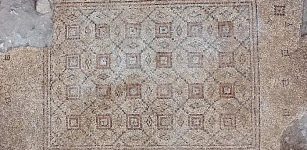 A 1,600-Year-Old Mosaic Accidentally Unearthed In Ancient City Of Yavne, Israel
Archaeology | Apr 26, 2021
A 1,600-Year-Old Mosaic Accidentally Unearthed In Ancient City Of Yavne, Israel
Archaeology | Apr 26, 2021 -
 Mystery Of The Faceless Creature – Ancient And Modern Sightings
Featured Stories | Jun 19, 2018
Mystery Of The Faceless Creature – Ancient And Modern Sightings
Featured Stories | Jun 19, 2018 -
 On This Day In History: Astronomer John Couch Adams And The Discovery Of Planet Neptune – On July 3, 1841
News | Jul 3, 2016
On This Day In History: Astronomer John Couch Adams And The Discovery Of Planet Neptune – On July 3, 1841
News | Jul 3, 2016 -
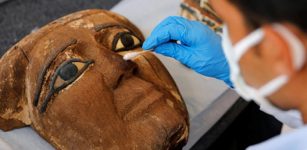 Saqqara Necropolis: Biggest Archaeological Discovery In 2020 – Photos Revealed
Archaeology | Nov 14, 2020
Saqqara Necropolis: Biggest Archaeological Discovery In 2020 – Photos Revealed
Archaeology | Nov 14, 2020 -
 Never-Before-Seen Roman-Era Wall Paintings Discovered In Ashkelon Revealed To The Public For The First Time
Archaeology | Aug 30, 2024
Never-Before-Seen Roman-Era Wall Paintings Discovered In Ashkelon Revealed To The Public For The First Time
Archaeology | Aug 30, 2024 -
 New Path For Early Human Migrations Contradicts A Single ‘Out Of Africa’ Theory
Evolution | Oct 5, 2023
New Path For Early Human Migrations Contradicts A Single ‘Out Of Africa’ Theory
Evolution | Oct 5, 2023 -
 Sōhei And Yamabushi: Fearsome Ancient Warrior Monks Of Japan
Featured Stories | Feb 26, 2022
Sōhei And Yamabushi: Fearsome Ancient Warrior Monks Of Japan
Featured Stories | Feb 26, 2022 -
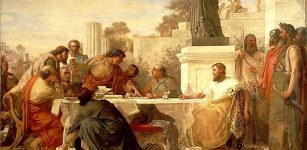 On This Day In History: Julian ‘The Apostate’ Died During The Retreat From The Sassanian Empire – On June 26, 363
News | Jun 26, 2016
On This Day In History: Julian ‘The Apostate’ Died During The Retreat From The Sassanian Empire – On June 26, 363
News | Jun 26, 2016 -
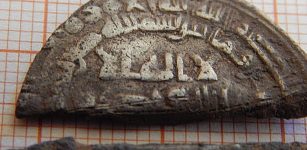 Treasure Trove Of Arabic Coins Dated Back 1,000 Years Unearthed In Graveyard In Poland
Archaeology | Jul 9, 2019
Treasure Trove Of Arabic Coins Dated Back 1,000 Years Unearthed In Graveyard In Poland
Archaeology | Jul 9, 2019 -
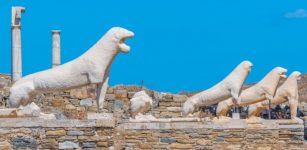 Archaic Marble Lions On The Sacred Island Of Delos
Artifacts | Feb 27, 2021
Archaic Marble Lions On The Sacred Island Of Delos
Artifacts | Feb 27, 2021 -
 95% Of All Modern Europeans Descended From The Seven Daughters Of Eve
Civilizations | Dec 12, 2019
95% Of All Modern Europeans Descended From The Seven Daughters Of Eve
Civilizations | Dec 12, 2019 -
 On This Day In History: Agatha Christie Known As ‘Queen Of Crime’ Died – On Jan 12, 1976
News | Jan 12, 2017
On This Day In History: Agatha Christie Known As ‘Queen Of Crime’ Died – On Jan 12, 1976
News | Jan 12, 2017

